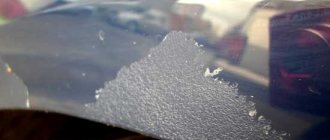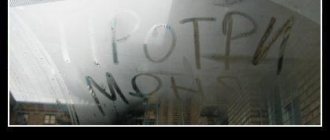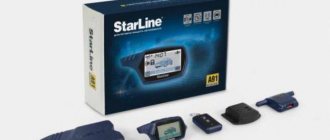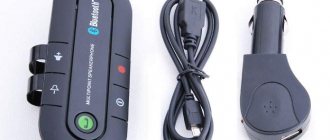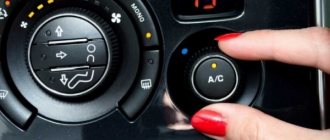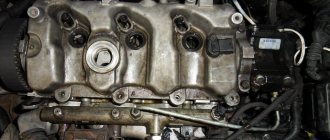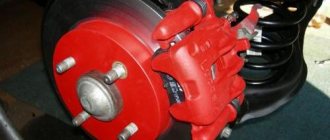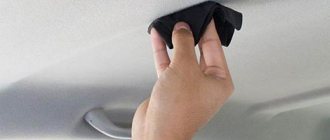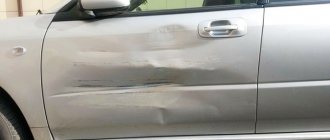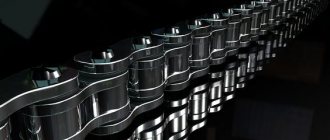Anti-glare visors
These are actually sun visors for cars, often called anti-glare visors.
Also in the names the concept of HD, that is, high resolution, often appears. In reality, these designs have nothing in common with high resolution.
The name is explained by the banal desire of manufacturers to attract attention to their products. Therefore, it is fair to consider this a marketing technique
But, despite everything, this technique worked great. The demand for anti-glare designs is growing rapidly.
The anti-glare visor is a fairly simple design. Most models use a pair of transparent screens in different colors. The most common are yellow and gray screens, which have good transmission capacity for human eyes.
But the most important thing here is that they do not let a large amount of light back through. This allows you to reduce the brightness of the sun's rays and headlights that are directed directly into the driver's eyes.
Yellow screens are designed for daytime use, that is, they protect directly from sunlight. Gray ones can be used at night, since their main task is to block light from headlights, while maintaining visibility for the driver.
Agree that driving in the evening and at night with glasses is not the best idea. The vents themselves can interfere, the windows will fog up, and the glass structure itself can significantly reduce the quality of visibility for the driver. This is dangerous because you can easily miss some obstacle. In the case of anti-glare agents, the likelihood of such a situation is significantly reduced.
Despite various advertising gimmicks and attempts by manufacturers to call their anti-glare visors something unique, in fact, the same light filters are used here as in the case of sunglasses. But since not everyone likes to wear the latter, and they completely cover the eyes with filters, the best solution would be visors.
Being at a certain distance, the screen will protect the eyes, but will not block the entire viewing angle for the driver. And this plays a decisive role in security issues. Especially when using the visor at night. Wearing tinted glasses in the dark while driving a vehicle is strongly discouraged. They can partially protect from headlights, but in the absence of oncoming cars, glasses are too dark. It's like making a circular tint that was done in violation of the permissible light transmission.
If we compare anti-glare visors with standard factory visors, the former also win. The thing is that classic visors are usually made on the basis of pressed pile or other dense opaque material. As a result, part of the road and roadside area is closed to the driver, and the canopy itself does not reduce the brightness of the light at all.
There is no point in talking about the operation of the standard visor at night. It does not protect against oncoming headlights in any way, and you will not be able to use them.
Transparent plastic is used in the production of anti-glare visors. A special film is applied on top of it, which creates the necessary anti-reflective effect. This allows the driver to look through the screen, clearly control everything that is happening around him, and at the same time not squint from the sunlight or from the headlights of oncoming cars.
Advantages of anti-glare visors
As manufacturers convince us, day-night anti-glare visors are practically vital for drivers. They cite the following advantages of transparent canopies as arguments:
- Reduces the brightness of sunlight by absorbing more than 97% of ultraviolet radiation. Thanks to this, the products not only improve visibility, but also reduce the level of sensitivity of the retina.
- Dimming the brightness of the headlights of oncoming cars by up to 28% (regardless of whether xenon or conventional optics are used).
- Improved visibility during fog. Thanks to the visor, the driver sees a larger section of the roadway.
- Easy to install the product yourself. The visor simply snaps on and unfolds like a regular standard device.
- Low cost. Sunglasses break all the time, whereas a visor will last much longer.
Why do you need a visor?
To prevent the windows from freezing in the car.
In total, there are 4 types of protecting the driver’s eyes from the bright sun or snow glare: film, sunglasses, an anti-headlight system and the visor itself. Most drivers prefer to tint their windows using film. But here the driver is in for a series of surprises. Traffic police inspectors are actively fighting against such protection. They give different arguments - from deterioration of visibility due to excessive shading to the inability to identify the driver on a crime or speed camera. Plus, not every film is suitable for use in the countries of the Customs Union.
Almost all of the above nuances also apply to glasses with anti-headlights. Ideally, anti-glare glasses should be prescribed by the attending physician, taking into account the patient’s vision characteristics. In practice, people buy glasses for themselves, cruelly paying for it with their health.
But the visor will not affect the visibility factors or the health of the driver. It won't get lost like glasses and won't arouse suspicion from a traffic inspector.
Methods of protection
What is called voltage and electric current. What is called voltage
There are several types of additional devices that can significantly reduce the level of discomfort of the driver when the headlights of oncoming cars or solar radiation are directed into his eyes.
For similar purposes the following can be used:
- special tinting films;
- external visors;
- universal anti-glare visors.
If we talk about films, they can often be found on various vehicles. To protect themselves from the sun, drivers stick a special strip on the windshield, which is installed in the upper part of the structure.
The good thing about the film is that it does not need to be constantly removed or installed, unlike factory visors, which are often used to store documents in internal pockets.
But the film only helps in situations where the sun is at a sufficient height, and the strip is able to partially cover it. When the sun drops lower, the effectiveness of such an element is reduced to zero.
No one excludes the option of using sunglasses. But not everyone feels comfortable wearing them, some simply forget to take them with them in the car, while others do not recognize these accessories at all.
An alternative to film is an external visor. Its peculiarity is that the structure is installed on the outside of the vehicle above the windshield.
In terms of combating the sun's rays, the external visors perform quite well. They are not inferior to tinted film, and in some cases they are even ahead of their competitors. But when the headlights of oncoming traffic shine into your eyes, the design is again of no use.
Increasingly, external visors are mounted not to protect against irritants such as sun and headlights, but to improve the appearance of the car. That is, these elements have become part of the external tuning.
The following facts speak in favor of canopies for outdoor installation:
- to a certain extent protect from sunlight;
- have an attractive appearance;
- prevent the accumulation of dust, water and snow;
- redirect air flows.
At the same time, they are useless against headlights, and not every motorist will want to install something similar on their car. The structure is easy to break; installation may require drilling holes in the body. And this is a direct threat to the development of corrosion if you do something wrong.
That’s why more and more motorists are switching to modern anti-glare vehicles. These visors have a number of distinctive features.
Why is a sun visor in a car dangerous? ForPost
A sun visor in a car is such an ordinary and familiar thing that many people do not even suspect the danger it can pose to a motorist.
Sun visors appeared in the 30s of the last century. Back then they were installed on the outside of cars - such visors were offered as a basic option. Then they came up with the idea of installing visors inside the car - they were given only to those motorists who were willing to pay for them as an option. Sometimes, visors were installed both outside and inside the car.
However, in the end, external visors lost their relevance. Firstly, they created a lot of noise, even though they had an aerodynamic shape, and secondly, the interior visors performed all the same functions and turned out to be more convenient due to the fact that they could install a mirror and even lighting.
Today it is difficult to imagine a car without sun visors. But, oddly enough, some motorists are not even aware of how to use it.
A small educational program : the sun visor serves to protect the eyes of the driver and front passenger from glare in bright sunshine, especially in the late afternoon when it tends to the horizon. Otherwise, the bright rays of the sun literally deprive the driver of his vision - the road is not visible, as well as oncoming traffic. And here there is every chance of getting into trouble.
If the sun is shining from the driver or front passenger side, then the visor will help again. It is enough to pull its right side (if it is a driver's visor) or its left side (if it is a passenger visor) to unfasten it. And then, you need to unfold it and cover part of the side glass with it. At the same time, sitting becomes noticeably more comfortable - the cheek and ear do not heat up, and there is no longer any need to squint.
There are also sun visors on some cars with additional extenders that extend to cover the small gap in the windshield that occurs when both the driver and passenger visors are open.
Another useful feature of the visor is the mirror. In more expensive cars it is equipped with a backlight - you move the protective flap covering the mirror and the backlight turns on; in cheap cars there is no backlight, but the flap is still present. I would like to dwell on the function of this very damper in more detail.
The interior mirror, alas, is made of glass - something that breaks very well if the car were to get into a more or less serious accident. Moreover, the mirror breaks into small, sharp pieces, which, if the protective flap did not close it, scatter throughout the cabin, digging into the interior plastic and the bodies of the driver and passengers.
Therefore, before starting to move, it is always worth not only looking at your appearance in the mirror, but also to make sure whether it is covered with a protective curtain. Otherwise, in the event of a strong collision, all these airbags, which cannot save your eyes and face from broken glass flying into them, are worthless.
Photo: newfrog.com
Nuances of installation and dismantling
Coating the body with liquid glass: pros and cons
There is nothing complicated about installing and removing car interior visors. To install the interior sun protection element, you only need to use your own hands. No additional tools are needed here.
- There is a special film on the visors, which creates the effect of a light filter. But upon purchase there is a protective film that can be easily removed in one motion. It is needed to protect the new screen from scratches and chips during storage, transportation, etc. When the driver installs the visor, the protective film can be removed.
- Anti-glares are equipped with special fastenings. Usually transparent plastic is used for their manufacture.
- To install the structure, you need to fix the clip on the factory visor in a suitable place. It's like hanging clothes on a clothespin. Only the quality of fixation on good screens is much higher.
- The anti-reflective glass will be held in place by the bottom of the clamp. This allows you to rotate the screens 180 degrees and change the tilt levels, selecting the most comfortable position for a particular driver.
- When night falls, a gray screen descends. It is designed to work specifically in the dark.
- If the driver does not need either of the anti-glare screens, the device is simply raised up and held near the ceiling.
- There is also nothing difficult about dismantling. When removing, you need to press the fasteners by hand and separate them from the factory visor.
Good products have a high level of strength, so even frequent removal and installation cycles will not lead to their breakage. The same cannot be said about budget screens.
But still try to be careful. There is no need to grab the screen with all your fingers. The process of raising and lowering is quite easy, and it only takes a little effort. Moreover, it is better to hold the element by the edge. Otherwise, the glass will always be covered in fingerprints.
Clean the surface of the anti-glare screen periodically. To do this, you can use alcohol wipes if there are traces, then walk over the screen with a dry cloth that does not leave marks.
A useful feature of a sun visor that many people don't know about!
Hi all. Today there will be another post about useful little things in your car, which, quite possibly, you don’t know about. It happens that you drive for half your life, but you simply don’t know about a little thing that can often be useful in certain cases.
So, the sun visor on your car most likely works in two main positions:
1. Raised and pressed to the ceiling, when the sun does not blind your eyes and you can drive calmly even without additional “protection”.
2. The visor is lowered and covers the upper part of the windshield, thereby protecting you from dazzling sunlight, which can greatly interfere with your view. And in some cases, glare can cause a serious accident, which I will talk about in the next article on the channel.
You can also adjust the position of the visor in intermediate positions, but most likely everyone already knows about this.
But there is another really useful function that many drivers simply do not know about. Agree, it happens that the sun blinds not the windshield, but the side, and in this case the visor in standard mode cannot help.
But here, too, everything is thought out, since it can be removed from one side of the mount and turned towards the door. Moreover, you can perform a similar operation on your car with both the driver and passenger visor.
On most cars, the visor rotates this way, but before you do this, be sure to check whether your car has such an option, so that God forbid, you don’t break anything.
If the article was interesting and the information was useful, do not forget to give a thumbs up and subscribe to the channel to be the first to receive notification of the release of new materials for car enthusiasts.
- Legendary, unforgettable Mercedes-Benz W116
- “My grandmother went to church on weekends”: How I saw through the deceitful outbid when buying a fresh Camry!
Category: Reviews
How to make a polycarbonate carport
This option involves installing a metal canopy with a pitched polycarbonate roof.
The site is fenced at a predetermined location. A layer of earth 300 mm deep is cut out. From the sides, at a distance of 1.5-2 m, recesses are dug for supports to a depth of 700-1000 mm. It is worth considering the presence of groundwater and soil characteristics.
Sand and crushed stone (about 100 mm) are poured into the bottom and compacted. The formwork and frame for the slab are made from rods with a diameter of 8 to 12 mm and cell sizes of 100x100, 200x200 mm.
When the concrete has hardened, we move on to further work. We make strapping along the tops of the supports by welding a 40x40 mm metal profile to the base. We fix the auxiliary harness at an angle of 90 degrees. to the supports. We get the shape of a right triangle.
Using welding, we secure the rafter stiffeners. We lay square metal rafters at right angles at a distance of 800-1200 mm. We weld a canopy over the edge of the trim.
All parts are cleaned and washed with solvent. Dry it. Apply primer and paint.
We cover the rafters with polycarbonate material, which is secured with press nuts to prevent moisture from seeping in, at a distance of 300-400 mm from each other. We seal the edges with special strips for the ends.
The sides of the canopy can be covered with a wooden lattice, awning curtains, etc.
Popular models
When choosing an anti-glare visor for a car, you should pay attention to its cost and manufacturer. There are a wide variety of screens available on the market, but only a few are considered to be the most effective and useful for motorists
There are a wide variety of screens available on the market, but only a few are considered to be the most effective and useful for motorists.
Motorists themselves identify the 2 most optimal options for anti-glare sun visors.
- HD Vision Visor. In popularity it is ahead of all competitors. A successful advertising campaign bears fruit. Don't be surprised, but the product is produced in China. Drivers have no complaints in terms of quality. The design has standard dimensions of 320x110 millimeters. It is characterized by a high level of wear resistance and lasts for many years. The estimated cost of the screen is 2 thousand rubles. Experienced drivers who have managed to evaluate the strengths and weaknesses of these plates do not recommend keeping the visor up all day. Otherwise your eyes will get tired. For periodic use, when the sun shines directly into the driver's eyes, this filter will become indispensable.
- Clear View. This is a relatively new product on the domestic market. But in the USA the filter is extremely popular. It is worth noting the adequacy of the manufacturer itself. He doesn't make any big claims about how their visor improves image clarity and the driver can miraculously look at the sun without squinting. We only talk about a decrease in eye sensitivity, which is actually felt. The picture does not change for the worse or for the better in terms of clarity. And this is logical. But the cost of the design is slightly lower than the previous model. On average, they will ask for about 1,500 rubles for a filter. Motorists themselves note that the visor works great during the day and in foggy conditions. And at night it is no different from its competitors.
If you don't want to spend that kind of money, there is a wide range of budget anti-glare designs on the market. Most of them are presented by completely unknown manufacturers. And there is no need to talk about a high level of quality here either.
There are models of visors that use a simple decorative film, which is passed off as a special light filter. The visor does not have any effect on sun glare, and the color allows the buyer to believe that this is an analogue of the Vision Visor or Clear View.
The budget category of visors is in the price range from 300 to 800 rubles. Be prepared for the fact that the structure will not last long in the car. The fasteners will begin to break, and the plate will begin to deform from exposure to ultraviolet radiation.
If you want to get all the benefits that were mentioned earlier, it is better not to waste money and purchase a really high-quality product from a trusted manufacturer. Such anti-glare products will definitely last for more than one year.
All for
For many drivers, the sun visor is a purely decorative element of external tuning. This is especially true for owners of SUVs, where the visor helps to style the car as authentic “Americans” of the 80s. Additionally, the accessory is equipped with side lights, which adds a special ambience. It has a visor and a completely functional purpose:
- protection from sun rays. Of course, the visor, like the tinted upper part of the windshield, will not be able to protect you from low-lying sun rays. The installation indirectly reduces the heating of the dashboard and interior. The effect, albeit small, is still present;
- prevents light from additional equipment installed on the roof. A pressing problem for SUVs with roof racks. The desire to maximize the volume of the luggage compartment leads to the fact that the headlights are installed close to the edge of the windshield;
- additional vehicle lighting at night. To do this, the deflector can be equipped with analogues of side lights;
- improving the aerodynamic characteristics of cargo vans. The visor in this case should be made in the form of a spoiler. Installing a properly designed sun visor can help keep snow from sliding off your truck's fairings. There are often cases when “avalanches” break off the windshield wipers.
Flaws
It is worth recognizing that the sun visor can also be characterized from a negative side:
- For installation it is necessary to make holes in the roof, the edge of the gutters or the rack. This must be done correctly, otherwise corrosion and further destruction of the paintwork cannot be avoided;
- deterioration of aerodynamics (with the exception of vans), which leads to increased fuel consumption;
- the likelihood of wind noise occurring at high speed. It is difficult to predict such a consequence, since everything depends on the compatibility of the accessory with the aerodynamics of the car model.
How to protect your car interior from the sun - Behind the Wheel magazine
May 28, 2020
Spring gives way to summer. The red sun begins to warm the earth, grass and flowers will begin to grow. But everything is good in moderation. Too much sun burns out all living things. It spares neither cars nor motorists.
Carport
An outdoor canopy is undoubtedly the best way to protect your car from the sun.
Protects not only the interior, but also the paintwork of the body. An outdoor canopy is undoubtedly the best way to protect your car from the sun. Protects not only the interior, but also the paintwork of the body. All experiments and calculations of how hot the interior was during two or three hours of exposure to the sun in central Russia look like childish pranks in comparison with how the sun comes off on cars and modest residents of the Maghreb. When I was young, I was transported to the Sahara by car. In Borj Moktar, Algeria, not far from the border with Mali, a man asks me to give him a place under a canopy, at least for a while, so that he can remove the cans from the trunk of his Peugeot. He thoroughly prepared for leaving for the desert and filled all the cans with gasoline. I put them in the trunk. The car stood in the sun - the canisters were swollen and burst from the heat so that none of them could be used.
So the first thing to do in defense against the ruthless Yarila is a canopy. And it doesn’t matter what it is made of, sheet iron or reeds - the main thing is that it does not let in the sun’s rays.
Car coverA car cover, just like a canopy, prevents the interior from heating up and the paintwork from fading. | Cover for carThis cover covers only the glass part of the car and the roof. |
Purchase
There are three ways to get a sun deflector:
- purchase a ready-made accessory produced industrially. You can use eBay by ordering a deflector from the USA. There are many options on the domestic car accessories market. The main advantage of this method is the presence of fasteners included in the kit and a ready-made solution for installation;
- make your own version of the visor. To do this, you will need not only skills in working with polyester resin and fiberglass, but also a lot of free time. You can get acquainted with the manufacturing process of fiberglass elements using the example of a fiberglass hood. Using this method, you can give the product the desired shape;
- make an accessory to order. If you wish, you can draw up a drawing depicting the desired shape. The price of such a deflector will include not only the materials spent, but also the payment for manual labor.
Kinds
Factory kits can be made of plastic, fiberglass or plexiglass (acrylic plastic). We can say that fiberglass products have the greatest safety margin.
As for the form, there are only two options:
- a spoiler is the best choice from an aerodynamic point of view. The kit should include soft stops to reduce vibration at speed;
- deflector that fits tightly to the roof. Leaf and dirt may accumulate at the junction with the roof. A constant source of moisture will lead to the rapid appearance of corrosion at the junction of the glass or the sealing rubber of the windshield and roof.
Deflectors can be frameless or framed. Frame – pipes laid on the inside, following the contours of the deflector. It is the tubular base that is attached to the car body, and the plastic body is already attached to the frame. This type of construction has a large margin of safety. In addition, additional lighting fixtures can be attached to the frame if desired.
We hope that listing the main features will help you choose the best windshield sun visor.
Self-installation
The sun visor is attached using self-tapping screws or special brackets and bolts with nuts. The kit should include all the necessary fasteners, so you just need to accurately mark the locations on the car body. Install the deflector using tape and pieces of foam to adjust the height and support. This way you can accurately mark the places to drill. The diameter of the hole should be 1-1.5 mm smaller than the size of the screw.
During installation, body sealant is applied to the mounting location. It is advisable to moisten the self-tapping screw in Movil before screwing it in.
other methods
Air conditioning/ventilation
No need to be afraid of air conditioners! They are healthier for the child than sitting in the stuffiness and heat. This opinion is common among many modern pediatricians. The only danger that can arise when blowing is strong drying of the air. It is dangerous for the baby. Therefore, you need to figure out how to humidify the interior while the air conditioner is running (this can be done with saline solutions; they need to be injected into the child’s nose at certain intervals). This way you will create an ideal environment for your baby.
Why do you need a sun visor?
Of course not - car sun visors provide purely practical benefits. For example, if such protection had not been installed on long-distance trucks, the driver would have had a hard time. Every day of his journey along the highway, he had to seek protection from the sun's rays, which mercilessly “sting” him in the cabin. And if we add here the unbearable heat and the deterioration of visibility due to glare, then not only would all driving comfort be reduced to nothing, but this would also threaten an accident.
And why only truckers? The absence of this element negatively affects drivers and other vehicles. As evidence, let us cite a case where a driver leaves a tunnel on a sunny, clear day. Probably, most experienced drivers have found themselves in this situation more than once and know what it’s like when there is no visibility at all and it is impossible to even see the hood of a car coming towards you. The sun strip somehow copes in these cases, but this is clearly not enough.
In addition to its purely practical value, the visor will give the car a truly excellent appearance. This item can either be purchased or ordered for a specific car model, especially one that was produced years earlier.
Visors can be of different shapes, colors and sizes
The ideal option, of course, is to install a factory kit that fits the car exactly and was specially prepared for it at the factory. In addition, the standard visor will match the design of the car, its color and other visual elements.
Needless to say, the part will need to be installed very carefully and with special care.
It is imperative to pay attention to compliance with the dimensions of the body. You should also carefully read the installation manual, because even the slightest violation will lead to insufficient fastening strength
An incorrectly installed visor falls off while driving - this must be remembered!
I wonder if it is possible to install this protection on car models of the domestic automobile industry? Of course you can. Even this production is open. In the city of Togliatti they began producing the first visors for models of the same car plant. The visor is made from polyurethane foam, a material whose weight for the visor is 2.5 kg. The sun visor is fastened with through bolts, and the product is covered with glass sealant.
Visors are especially important for Russian realities. We don't hold tinted windows in high esteem, including windshields. Installing them is punishable by law, so you have to somehow deal with the sun's rays. This is where installing a visor helps.
Cost of glass visors
The average price of a glass canopy is 15,000 rubles. per square meter.
The exact cost of a glass canopy depends on the complexity of the design, type of fastening, quality of fittings and additional functions: heating, lighting, tinting.
By ordering a glass structure from WoodGlass, you save on delivery and eliminate intermediaries. We purchase glass and metal directly from manufacturers, so we can make a visor of any shape and size for you.
Leave a request and receive a quote within 1 day!
Let's get to know each other better
This part is small in size and is mounted at the ceiling level of the vehicle, reliably protecting the driver’s eyes. After some time, phenomena such as squinting or dry eyes disappear. According to its design, the visor can be external or internal. Let's take a closer look at them.
Vodool
External
Suitable for exterior body tuning. Attaches to both windshield and rear windows. It is not able to fully guarantee protection, especially during periods of low sun - in the morning and evening. But throughout the rest of the day, in foggy weather or at night, such protection is justified.
If we talk about aerodynamic properties, then the visor does not have a significant effect on them. Much worse is an open hatch, an overloaded trunk or open windows. In short, any non-streamlined object.
The installation process is best done with two people. One person holds the visor, and the second marks the locations of the holes in the body no more than one millimeter in diameter. The holes must correspond to the location of the standard visor holes. The visor itself is fixed with sealant and tightened with self-tapping screws. Strongly protruding elements can be decoratively puttied.
Before June 1, 2020, such protection measures were popular among car owners. But now any jewelry will have to be registered with a mark in the passport. And this is additional trouble.
CSL 2018
Interior
The internal visor is installed with a clamp on top of the standard one. Its type of design is called day-night. It is divided into two stripes - yellow, which eliminates glare at night with an efficiency of 73%, and dark gray, which increases clarity in snowfall, glare or fog.
The advantages of such filtration are obvious - protection is provided constantly. It is convenient to adjust - raise up, lower or set the desired light filter without extra effort, without being distracted from driving the car. In case of side glare, it can be rotated 180 degrees. You don't even need to get out of the car! And the final argument in favor of the internal visor is that it does not need to be registered.
FAQ
Which sunblinds for cars are better: for the windshield, rear or side?
The choice of curtain depends on the driver's needs. If he most often drives alone in the car and he needs curtains to protect himself from the blinding rays of the sun, then it is better to install them on the windshield and side front windows. In this case, the standard of light transmission must be observed. If you need to protect passengers or prevent materials from burning out in the cabin, curtains for the rear and side rear windows are suitable; there is more choice here. Note! Cars that have curtains covering only the rear windows or both the rear and front windows look harmonious.
Are there any fines for sun blinds?
They are fined, but only if traffic rules are violated. The rules do not prohibit the use of curtains of any type for the rear and side rear windows if both rear-view mirrors are present. That is, the rear of the car can be tightly closed with curtains. The front part is more complicated: here the light transmission limit is set for the front and side windows. Curtains for these glasses must transmit at least 70% of the light. You can find out the light transmittance coefficient on the packaging. But it should be borne in mind that it may not coincide with the real one. In this regard, it is safer to buy high-quality curtains from trusted manufacturers. Although they are more expensive than budget options, with them you don’t have to be afraid that during an inspection a traffic police officer will issue a fine.
Above we discussed the main types of sun blinds for cars, their advantages and disadvantages. If you follow the rules, this is the best option for protection from heat, direct sunlight, and harmful ultraviolet radiation. The choice of a specific curtain always remains with the driver, because only he can evaluate the need for certain characteristics and the ease of use of each option for himself. Here are only recommendations to help you make the right choice.
Why do you need a visor?
This is easy to prove if you imagine the usual situation when the sun’s rays fall on a transparent “windshield”, thereby making visibility zero. And if the driver leaves, say, a tunnel, then there is no visibility at all. We can definitely say that in this case it will be impossible to see anything beyond the hood of the car. It is in these situations that not only a sun strip will help, but also a visor over the windshield will not be superfluous.
Car with a visor on the windshield
In addition, this element will not only add originality to your car, but will also create a comfortable ride during daylight hours. As a rule, such parts can be easily found in factory versions. Also, each driver has the opportunity to make a visor for the windshield to order; this is usually done if the car was produced a long time ago and no spare parts can be found for it.
We will deliver and install throughout the Russian Federation
Our own fleet of vehicles for installation and transportation of large glass, weighing up to 1200 kg.
Glass canopies and canopies made of tempered glass or EVA triplex glass:
We will produce a glass canopy in our production and install it at your place within 5 days. We will arrive for measurement within 12 hours!
Checks are being carried out
Rospotrebnadzor, UGPS and APU (we will help you obtain permission for installation).
Withstand snow loads
(at least 200 kg/m2), impacts from falling icicles, and triplex glass can withstand the impact of bricks.
They look respectable
on the facades of hotels, cafes, restaurants, private houses and cottages.
Best models
Most popular models can be purchased on AliExpress or similar. There are thousands of inexpensive models available in the catalog, both for universal use and for specific machines. Let's look at the best options for visors.
Deflector YCUNZ
- Deflector for YCUNZ for Toyota. In addition to traditional functionality, the device reduces raindrops falling onto the windshield, which creates an additional advantage for the driver.
- Internal Vodool is suitable for all cars. The visor can work in any conditions, because its temperature limit is 120 degrees. It can handle an additional load of 100 kilograms.
- Carsun is a little different from previous models. It protects the driver's eyes by automatically darkening the most blinding areas of the horizon.
- Along with the need to protect the driver's eyes, protection is also required for gadgets - navigator, on-board computer
etc. The CSL 2020 visor, which protects screens from glare and glare, will cope with the task. With such an assistant, the driver will not get lost and will be able to see the route more clearly on the screen.
Pros of curtains
- It is inexpensive - around 10 dollars (500 rubles);
- It is easy to mount: it can be installed on any window in a couple of minutes and can be removed just as quickly if necessary;
- There is no need for expensive film wrapping, which would partially disassemble the car and spoil its appearance;
- Leaves the view from the window open for the child;
- It gives a thick shadow;
- If there is no sun, it can be raised.
Editor's choice: How to wear a ring sling: step-by-step instructions
DIY visor for UAZ Patriot
Today, many Russian motorists are switching to UAZ Patriot. And they support the domestic auto industry, and the SUV is excellent - even if you drive through a swamp. Installing a visor on a UAZ is just a dream. The factory does not produce it, but you can order it and install it yourself.
Let us immediately note that you need to order a visor made of fiberglass so that it is not heavy and durable. In addition, it will be resistant to heat, frost and branches, which mercilessly whip the windshield when driving through forest alleys or simply tree-lined roads.
The first step is to try on a custom visor. Who knows, maybe it won’t fit, although the dimensions are all taken into account during manufacturing? Next you will need to secure the visor with 10 self-tapping screws. But first, silicone adhesive-sealant, preferably transparent, is applied under the visor. After fixing the visor with self-tapping screws, the caps are primed and painted to match the color of the product.
Driving screws into a car body is not that difficult. The main thing is that in this case you need to use a drill of the same diameter. 3.5 mm will do.
Marking the holes is a complicated matter. It is better to do this with a fresh mind. “Measure twice, cut once” - just about this case. Acetone and anticorrosive, which degreases surfaces, are useful for marking. Before drilling, you need to soften the holes.
The procedure will look like this:
- The holes for the screws are softened and drilled.
- The visor is tried on using the holes.
- The surface of the body and visor, as well as the holes, are treated with anticorrosive.
- The sealant is applied.
- You can optionally install 5 more diodes of any color into the visor. The cable runs 3 meters on the left under the windshield and then runs through the fender under the hood and into the cabin.
After installing the visor on the UAZ Patriot, the noise of air rushing in during fast driving at speeds of 100 - 110 km/h or more may increase. But we hasten to reassure you: this feeling only occurs when the car windows are open. And even without a visor on the UAZ Patriot, when you accelerate, the noise from the incoming air is not weak, but you don’t notice it, since at such a speed you always have to close the windows.
There were no changes in fuel consumption. The material is light and there is no burden on the SUV. As for the design, it fits “tightly”. If everything is done correctly, no vibrations or rattles will be noticed.
Now let's calculate the costs. A custom-made visor will cost about 6,000 rubles. Delivery depending on the distance - well, let it be about 1000 rubles. Painting the product – 2500 rubles. Total 9500 rubles.
Still, it is necessary to install a sun visor, and the information given in the article is further proof of this.
Dimensions
For a medium-sized car, an area of 5x2.3 m is sufficient, for large ones such as crossovers or minibuses - 6.6x3.6 m. Two cars will fit perfectly on an area of 6.3x5.9 m.
The standards provide for the following canopy dimensions:
- length is 1 m longer than the length of the machine,
- the width is 1-2 m more, for two units - 2.8 m (1 m on the sides and 0.8 between them) more than their total width.
Options for canopy designs with all calculations and instructions can be found on the Internet and built on your own. Or you can hire qualified specialists who will prepare projects according to your wishes and bring them to life for an appropriate fee.
